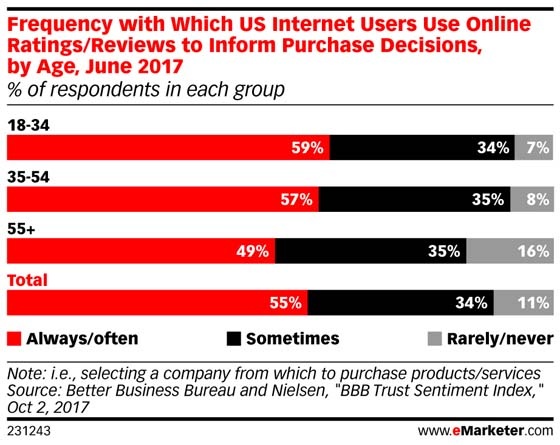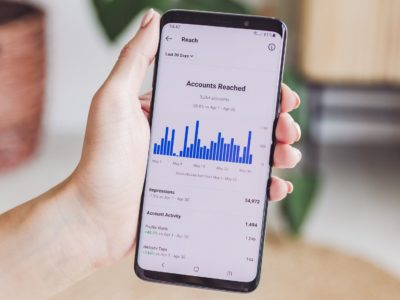The best marketing messages come not from ads alone, but from word of mouth. Before making a purchase, shoppers look to product and store reviews for reassurance. If there are no customer reviews, shoppers will conclude that no one buys from you—and why should they?
Reviews are highly influential in customers’ purchase decisions. Better Business Bureau and Nielsen conducted a study of US Internet consumers and found that more than half of the participants refer to online reviews before purchasing. Clearly, having customer reviews is essential in today’s online shopping world.

(Source)
Sometimes customers just don’t think to leave a review, even if you provide exceptional products or services. In this case, you need to persuade customers to leave reviews. Then highlight the most positive reviews on your Facebook page, Amazon product page, or website.
Here are six ways to get more customers to leave reviews:
1. Request Reviews Via Email
Whether sending it as a mass email to everyone on your customer list or only sending it to high-value customers after a recent purchase, send an email that requests a review. The copy can be as simple as “Tell us how we’re doing. Leave us a review!”
Within the body of the email, also include links to your social media or product pages, making it easy for your customers to click and review. Personalizing the email for each customer is a very effective tactic that shows how much your brand cares about their audience as individuals. Customers will feel like a priority and thus be more likely to leave a review.
2. Promote Existing Reviews
Highlight the reviews other customers have already provided. You can create a web page dedicated solely to reviews, allow customers to leave reviews on your Facebook page, or even promote your best customer reviews and testimonials in ads.
Reviews are a type of user-generated content, Ad Espresso explains. They give your business a grounded appeal. When shoppers see the reviews others have left in such a highlighted fashion, they’re more likely to follow suit. Think of them as a unique competitive advantage that that sets you apart from your competitors.
3. Offer Incentives in Exchange for Reviews
As long as you use a platform that allows it, you can offer incentives to customers in exchange for reviews. For example, you may offer 20 percent off an entire purchase when a customer leaves a Facebook review.
According to Kissmetrics, the better the incentive, the more reviews you’re likely to get. These incentives can be promoted in email blasts or social media ads containing call-to-action buttons customers can click to leave a review. It’s a simple tactic that doesn’t cost customers anything.
4. Keep Negative Reviews and Respond to Them Promptly
Allowing customers to see even your negative reviews improves your credibility because it communicates transparency. According to Ad Espresso, you can hurt your image by deleting negative reviews, because if customers catch on, they’ll consider you deceptive.
But don’t just allow negative reviews to hang like a dark umbrella, casting a shadow over the positive ones. Put your customer service skills to work and reply to negative reviews right away, perhaps even offering a special incentive to make up for the customer’s bad experience.
When other customers observe your stellar customer service, they’ll perceive your business more positively. As a result, they’ll be more inclined to leave customer reviews about their experiences.
5. Make the Price Right
According to Emarketer, one in three shoppers will still buy from a business with negative reviews if the price is irresistible. If the price is that irresistible, and you have a product of great value, customers will be more apt to write positive reviews about it.
So consider the price and value of your product to see if any adjustments are possible to generate those reviews and subsequently increase your sales.
6. Just Ask
Whether you ask in a pop-up immediately after a customer makes an online purchase or even face-to-face after an in-store purchase, it never hurts to ask. The sooner you ask after a purchase, the more likely the customer is to oblige.
Perhaps you’ve noticed other businesses do this in the form of hard-copy receipts with links to review sites or “Rate Your Experience” windows that open on a website where you just made a purchase. Simply asking has a transparent appeal and shows that you truly care about the customer experience. It shows them that they help you by leaving a review, which is empowering. And who doesn’t like to feel empowered?
Conclusion
Customer reviews reflect the types of relationships you have with your customers. They’re a marketing step you should never ignore.
Reviews and testimonials speak louder than any promotional copy you create. As they become easier to share on social media and mobile devices, it’s essential to have a thoughtful strategy dedicated solely to generating customer reviews.
Whether you use one of the ways discussed in this article or an entirely different strategy you find upon additional research, make your customer relationships a priority.
Remember: the customer is always right.







